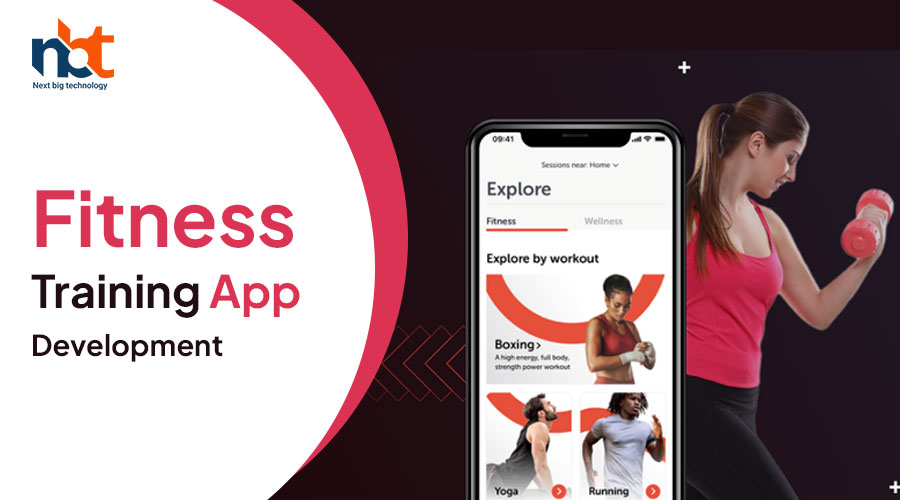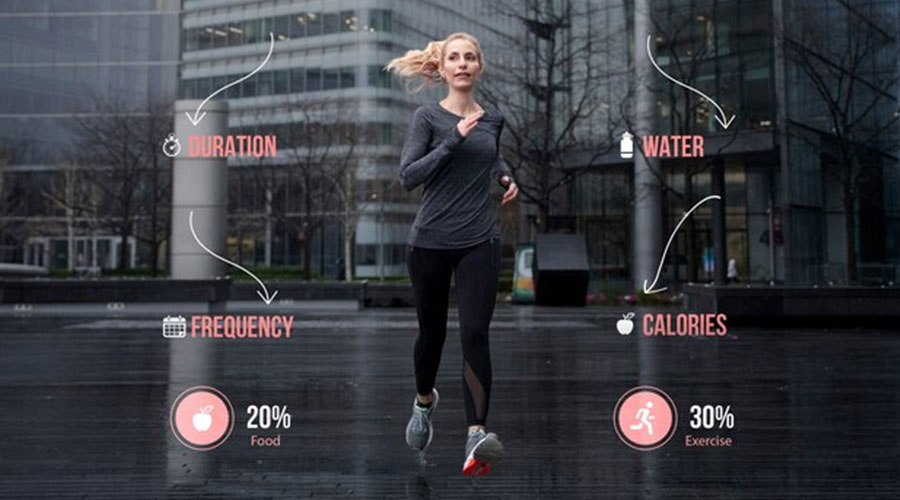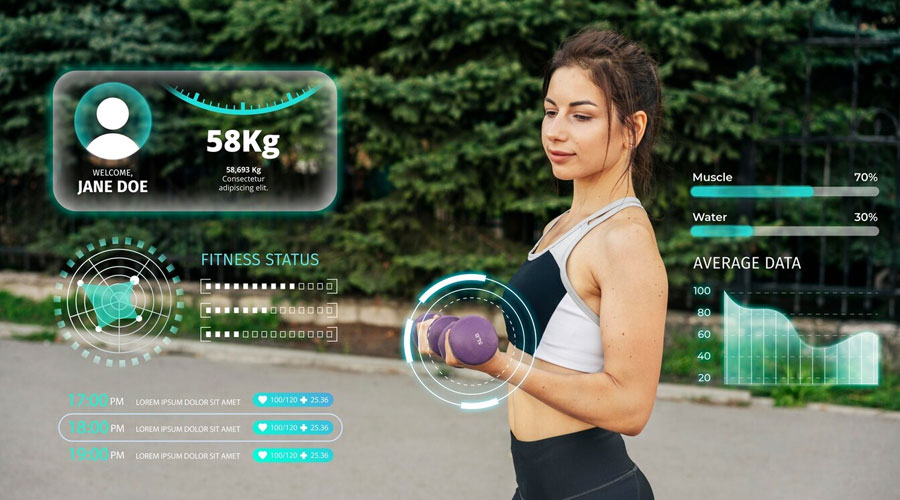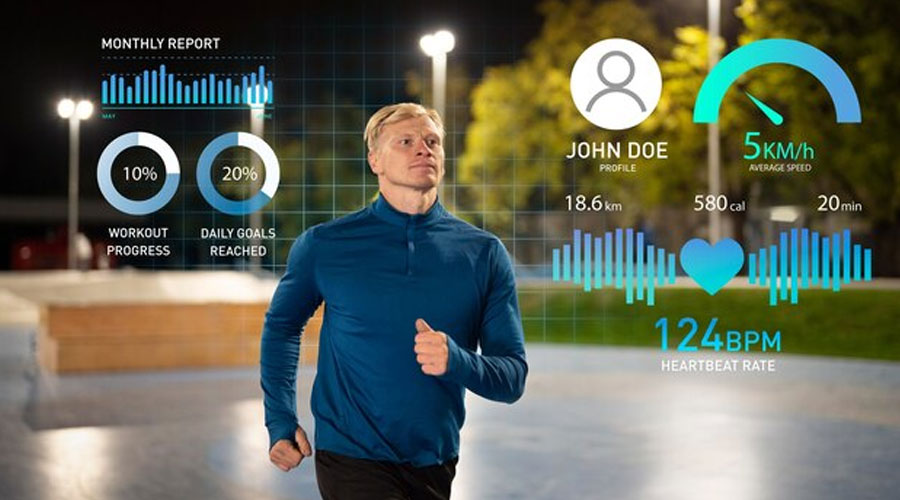Table of Contents
Introduction to Fitness Training App Development
In an era dominated by technology, the fusion of fitness and digital innovation has given rise to a groundbreaking trend: Fitness Training App Development. As society becomes increasingly health-conscious, the demand for personalized and accessible fitness solutions has paved the way for the evolution of mobile applications designed to cater to the diverse needs and goals of individuals seeking a healthier lifestyle.
The Evolution of Fitness Training Apps:
The journey of fitness training apps began as a response to the growing challenges individuals face in incorporating regular exercise into their hectic lives. With the advent of smartphones, developers recognized the potential to create platforms that could transcend traditional barriers to fitness. These apps emerged as tools capable of providing personalized workout plans, nutritional guidance, and progress tracking, thereby revolutionizing the way people approach their fitness journeys.
The Need for Personalization:
One of the driving forces behind the success of fitness training apps is their ability to offer a highly personalized experience. These apps leverage user input, such as fitness goals, current health status, and preferences, to craft bespoke workout routines and nutrition plans. The emphasis on personalization not only enhances user engagement but also addresses the diverse needs of individuals with varying fitness levels and objectives.
The Core Features Redefining Fitness Apps:
1. Customizable Workouts: Fitness training apps boast an extensive array of workout options, ensuring users can find routines that align with their preferences and goals. From high-intensity interval training (HIIT) to yoga and strength training, these apps cater to a broad spectrum of fitness enthusiasts, making the experience both versatile and enjoyable.
2. Progress Tracking: The incorporation of progress tracking features is a pivotal aspect of fitness app development. Users can log their workouts, monitor nutritional intake, and track changes in key metrics over time. This data-driven approach not only empowers users with insights into their progress but also serves as a motivating factor, encouraging them to stay committed to their fitness regimens.
3. Integration with Wearables: To enhance the user experience, many fitness training apps seamlessly integrate with wearable devices, such as fitness trackers and smartwatches. This integration enables real-time monitoring of activities, heart rate, and other vital metrics. By providing users with a holistic view of their health and fitness, these apps contribute to a more comprehensive and informed approach to wellness.
4. Social Connectivity: Recognizing the importance of community and support in the fitness journey, developers have integrated social features into these apps. Users can connect with friends, participate in challenges, and share achievements, fostering a sense of camaraderie and motivation. The social dimension adds a unique and interactive element to individual fitness pursuits.
Challenges and Innovative Solutions:
While the fitness app industry continues to thrive, it is not immune to challenges. Intense competition and the need to sustain user engagement present ongoing concerns for developers. To overcome these challenges, the integration of cutting-edge technologies such as artificial intelligence (AI) and machine learning (ML) has become a focal point.
1. Artificial Intelligence for Personalization: AI algorithms play a crucial role in enhancing app personalization. By analyzing user data, AI can generate intelligent workout recommendations, adapting to individual preferences and performance levels. This dynamic personalization ensures that users receive tailored fitness guidance, keeping their routines engaging and effective.
2. Machine Learning for Predictive Analytics: Machine learning algorithms contribute to the predictive analytics capabilities of fitness apps. These algorithms can analyze user behavior patterns, predict trends, and offer insights into potential improvements in workout plans or nutritional recommendations. The iterative learning process of machine learning ensures that the app evolves alongside the user’s changing needs.
3. Gamification to Boost Engagement: To address concerns regarding user engagement, developers are increasingly incorporating gamification elements into fitness apps. Gamification involves integrating game-like features such as rewards, challenges, and competitions. This not only adds a fun and competitive aspect to the fitness experience but also serves as a powerful motivator, encouraging users to stay committed to their goals.
4. Virtual Reality (VR) for Immersive Workouts: As technology advances, virtual reality is emerging as a game-changer in the fitness app landscape. VR can provide users with immersive workout experiences, transporting them to virtual environments that make exercise more engaging and enjoyable. This innovative approach not only enhances user satisfaction but also introduces a new dimension to home-based fitness routines.
Key Features for a Successful Fitness App
In the dynamic landscape of fitness app development, success hinges on the ability to deliver a comprehensive and engaging user experience. A successful fitness app is not just a tool for tracking workouts; it’s a holistic platform that motivates, educates, and adapts to the unique needs of its users. In this exploration, we delve into the essential key features that contribute to the triumph of a fitness app, making it a powerful companion on the journey to health and wellness.
1. Personalization and Adaptive Workouts:
The cornerstone of any successful fitness app lies in its ability to cater to individual needs. Personalization goes beyond asking for the user’s fitness goals; it involves understanding their preferences, fitness levels, and even their daily schedule. An app that can adapt and generate customized workouts based on user data ensures a more engaging and effective fitness experience.
2. Comprehensive Workout Libraries:
Variety is the spice of life, and the same holds true for fitness routines. A successful fitness app should offer a diverse range of workouts to accommodate users with different preferences and fitness levels. From high-intensity interval training (HIIT) and strength training to yoga and cardio exercises, a well-rounded workout library keeps users engaged and motivated.
3. Progress Tracking and Analytics:
The ability to monitor progress is a fundamental motivator for individuals on their fitness journey. A successful fitness app should provide users with robust tools for logging workouts, tracking nutrition, and visualizing their progress over time. Integrating charts, graphs, and performance analytics not only empowers users but also enhances their understanding of the impact of their efforts.
4. Integration with Wearable Devices:
The synergy between fitness apps and wearable devices has become increasingly vital. Integrating with popular wearables such as fitness trackers and smartwatches allows for real-time data synchronization. Users can seamlessly monitor their heart rate, step count, and other relevant metrics, fostering a more accurate and comprehensive overview of their overall health and fitness.
5. Artificial Intelligence and Machine Learning:
The integration of artificial intelligence (AI) and machine learning (ML) is a game-changer in the realm of fitness app development. These technologies can analyze user behavior, adapt to preferences, and offer intelligent workout recommendations. By continuously learning from user data, the app becomes a dynamic and evolving fitness companion, providing tailored suggestions for optimal results.
6. Nutrition Guidance and Meal Planning:
A holistic approach to fitness encompasses not only exercise but also nutrition. Successful fitness apps often include features for tracking dietary habits, offering nutritional advice, and even creating personalized meal plans. Integrating a comprehensive nutrition component ensures that users can address both sides of the health and wellness equation.
7. Gamification and Social Connectivity:
Turning fitness into a game can significantly boost user engagement. Gamification elements, such as challenges, achievements, and rewards, make the fitness journey more enjoyable and competitive. Additionally, social connectivity features allow users to connect with friends, join fitness communities, and share achievements. The sense of community and friendly competition can serve as powerful motivators.
8. Real-time Feedback and Coaching:
Providing real-time feedback during workouts adds an interactive dimension to the fitness app experience. Whether through audio cues, video demonstrations, or virtual coaching, users benefit from immediate guidance and corrections. This feature not only improves exercise effectiveness but also enhances user confidence and adherence to proper form.
Social Connectivity and Community Building Features
In the dynamic landscape of fitness training app development, the integration of social connectivity and community building features has emerged as a pivotal aspect. Beyond personalized workouts and progress tracking, these features contribute significantly to user engagement, motivation, and overall success in achieving health and wellness goals. In this comprehensive exploration, we delve into the importance of social connectivity, the impact of community building features, and how they are reshaping the fitness app industry.
I. The Power of Social Connectivity:
A. Building a Supportive Network: In the realm of fitness, the journey is often more enjoyable and sustainable when it’s shared. Fitness training apps leverage social connectivity to allow users to connect with friends, family, or like-minded individuals who share similar fitness goals. This connection fosters a sense of community, encouragement, and accountability, creating a supportive network that can significantly impact an individual’s fitness journey.
B. Motivation through Social Sharing: The integration of social media features within fitness apps enables users to share their workout achievements, milestones, and progress. This not only serves as a personal record but also becomes a source of motivation for others in the community. The ability to receive positive feedback, encouragement, and recognition from peers can be a powerful catalyst for individuals to stay committed to their fitness routines.
C. Group Workouts and Challenges: Social connectivity features extend beyond personal connections to include group workouts and challenges. Fitness apps facilitate the creation of virtual fitness communities where users can join challenges, compete with friends, and collectively work towards common goals. This collaborative approach enhances the overall experience, making fitness more engaging and enjoyable.
II. Community Building Features:
A. Forums and Discussion Boards: To further enrich the user experience, fitness training apps often include forums and discussion boards where users can share tips, ask questions, and engage in discussions related to health, fitness, and nutrition. These virtual spaces foster a sense of belonging and provide a platform for users to seek advice, share experiences, and build lasting connections with fellow fitness enthusiasts.
B. Expert-led Communities: Some fitness apps go a step further by incorporating expert-led communities. These communities may include certified trainers, nutritionists, and health professionals who actively participate in discussions, provide guidance, and share valuable insights. The presence of experts enhances the credibility of the app and ensures that users have access to reliable information on their fitness journey.
C. Real-time Interaction: Live streaming and real-time interaction features are becoming increasingly popular in fitness apps. Users can join live workout sessions, participate in Q&A sessions with fitness experts, and engage in real-time discussions with other users. This real-time interaction not only adds a dynamic element to the app but also creates a sense of immediacy and connection.
III. The Impact on User Engagement:
A. Enhanced Motivation and Accountability: The social connectivity and community building features in fitness apps contribute significantly to user motivation and accountability. Knowing that others are aware of their fitness goals and achievements encourages users to stay consistent with their workouts. The sense of accountability to a virtual community can be a powerful motivator, helping users overcome challenges and stay on track.
B. Long-term Engagement and Retention: Apps that successfully integrate social features often experience higher levels of user engagement and retention. The sense of community creates a bond between users and the app, making it a central part of their fitness routine. Long-term engagement is crucial for the success of fitness apps, and the community-building aspect plays a vital role in achieving this sustained involvement.
C. Positive Impact on Mental Well-being: Beyond physical fitness, the social connectivity in fitness apps positively influences mental well-being. The supportive environment, encouragement from peers, and the ability to share experiences contribute to a sense of belonging and emotional well-being. This holistic approach to health enhances the overall impact of fitness training apps on users’ lives.
IV. Challenges and Considerations:
A. Maintaining a Positive Environment: While social connectivity and community building features offer numerous benefits, maintaining a positive and inclusive environment is essential. Fitness app developers must actively moderate communities to ensure that interactions remain respectful and supportive. Implementing guidelines and reporting mechanisms can help address any instances of negativity or inappropriate behavior.
B. Privacy and Security Concerns: As users share personal achievements and progress within the community, privacy and security become paramount. Fitness app developers need to prioritize robust security measures to protect user data and ensure a safe environment for all users. Clearly communicated privacy policies and user controls can help address concerns related to data security.
C. Balancing Individualization and Community Dynamics: Striking the right balance between personalized experiences and community dynamics is a challenge for fitness app developers. While personalization is crucial for addressing individual fitness goals, the community-building features should enhance, not compromise, the user’s unique journey. Customizable privacy settings and user controls become crucial in achieving this balance.
Nutrition Tracking and Meal Planning in Fitness Apps
In the ever-evolving landscape of fitness training app development, the inclusion of nutrition tracking and meal planning features has become a game-changer. Recognizing the crucial role that diet plays in overall wellness, developers are integrating advanced functionalities into fitness apps to provide users with comprehensive tools for achieving their health and fitness goals. This article explores the significance of nutrition tracking and meal planning within fitness apps, examining the impact on user engagement, health outcomes, and the future of holistic wellness.
I. The Interconnectedness of Fitness and Nutrition:
Understanding that a holistic approach to health is essential, fitness apps are increasingly incorporating nutrition-related features. The symbiotic relationship between fitness and nutrition is undeniable, and addressing both aspects ensures a more comprehensive and effective wellness strategy.
II. Nutrition Tracking:
A. The Importance of Monitoring Dietary Intake:
- Caloric Tracking: Nutrition tracking enables users to monitor their daily caloric intake, a fundamental aspect of weight management and overall health. Apps allow users to log food consumption, providing insights into their nutritional choices and helping them make informed decisions.
- Macro and Micronutrient Analysis: Going beyond calorie counting, advanced apps offer users the ability to track macronutrients (proteins, fats, and carbohydrates) and micronutrients (vitamins and minerals). This level of detail empowers users to ensure a well-balanced diet that meets their specific nutritional needs.
-
B. Integration with Food Databases and Barcode Scanning:
- Extensive Food Databases: Fitness apps often integrate vast food databases, allowing users to easily log their meals. These databases provide nutritional information for a wide range of foods, simplifying the tracking process.
- Barcode Scanning: To streamline data entry, many apps support barcode scanning, enabling users to scan product barcodes for instant nutritional information. This feature enhances the accuracy and efficiency of nutrition tracking.
III. Meal Planning:
-
A. Customized Meal Plans:
- Aligning with Fitness Goals: Fitness apps with meal planning capabilities take personalization to the next level by generating customized meal plans based on individual goals, dietary preferences, and restrictions. Whether the objective is weight loss, muscle gain, or overall wellness, users receive tailored recommendations.
- Variety and Flexibility: To cater to diverse tastes and dietary preferences, meal plans often incorporate a variety of recipes and food options. Users can explore new dishes while ensuring their nutritional requirements are met.
-
B. Integration with Grocery Lists:
- Seamless Shopping Experience: Many fitness apps simplify the meal preparation process by integrating grocery lists with meal plans. Users can generate shopping lists based on their selected recipes, ensuring they have all the necessary ingredients for their meals.
- Nutritional Consistency: By combining nutrition tracking and meal planning, users can maintain nutritional consistency. The app can adjust meal plans based on the user’s tracked dietary intake, creating a dynamic and adaptive approach to nutrition.
IV. The Impact on User Engagement:
-
A. Motivation and Accountability:
- Comprehensive Progress Tracking: The combination of fitness tracking, nutrition monitoring, and meal planning creates a holistic approach to progress tracking. Users can see the direct correlation between their dietary choices and fitness outcomes, fostering a sense of accountability.
- Visualizing Achievements: Nutrition tracking allows users to visualize their dietary achievements alongside their fitness progress. Seeing tangible results in both areas enhances motivation and encourages continued engagement with the app.
- B. Educational Component:*
- Nutritional Education: Fitness apps with robust nutrition features often include educational components. Users can learn about the nutritional value of foods, the importance of various nutrients, and how dietary choices impact their fitness journey. This knowledge empowers users to make informed decisions beyond the app.
- Behavioral Change: The integration of nutrition tracking and meal planning contributes to behavioral change. Users develop a deeper understanding of their eating habits, leading to more conscious and healthier food choices.
V. Challenges and Future Developments:
-
A. Data Accuracy and User Compliance:
- Ensuring Accuracy: One challenge in nutrition tracking is maintaining data accuracy. Developers continually refine algorithms and databases to provide users with reliable nutritional information.
- User Compliance: Encouraging users to consistently track their nutrition and follow meal plans can be challenging. Developers are exploring gamification, rewards, and personalized nudges to enhance user compliance.
-
B. Artificial Intelligence and Machine Learning:
- Predictive Analysis: The integration of artificial intelligence (AI) and machine learning (ML) allows apps to analyze user data and predict future trends. This can include anticipating dietary preferences, suggesting meal plans, and adapting to changing fitness goals.
- Enhanced Personalization: As AI continues to advance, the personalization of nutrition and meal plans will become even more sophisticated. Apps may leverage AI to consider individual responses to specific foods, creating highly tailored recommendations.
Future Trends in Fitness App Development
The fitness app industry is evolving rapidly, driven by technological advancements and an increasing awareness of the importance of health and wellness. As we gaze into the future, the landscape of fitness app development is poised to witness transformative changes, introducing innovative features and capabilities that will redefine the way individuals engage with their fitness routines. In this comprehensive exploration, we delve into the anticipated future trends in fitness app development, examining how emerging technologies and evolving user preferences will shape the next generation of wellness solutions.
- Integration of Augmented Reality (AR) and Virtual Reality (VR):The integration of AR and VR technologies is set to revolutionize the fitness app experience. Imagine being able to take a jog through a virtual forest or attend a yoga class on a serene beach without leaving your living room. AR and VR can enhance user engagement by providing immersive and interactive workout environments, making fitness more enjoyable and motivating.
- AI-Powered Personalization:The future of fitness app development lies in leveraging the power of artificial intelligence for enhanced personalization. Advanced AI algorithms will analyze user data, including fitness levels, preferences, and biometrics, to generate highly tailored workout plans and nutrition recommendations. This level of personalization ensures that users receive the most effective and enjoyable fitness experiences, thereby increasing adherence to their wellness goals.
- Gamification for Increased Motivation:Gamification has proven to be an effective strategy in motivating users to stay active and engaged. Future fitness apps are likely to incorporate more gamified elements, such as challenges, rewards, and virtual competitions. By tapping into the competitive and achievement-driven nature of individuals, gamification not only enhances motivation but also fosters a sense of community and friendly competition among users.
- Biometric Monitoring and Health Insights:The integration of advanced biometric monitoring capabilities will empower fitness apps to provide users with comprehensive health insights. From real-time heart rate variability analysis to sleep pattern monitoring, these apps will offer a holistic view of users’ health. Such insights will not only guide workout recommendations but also enable users to make informed decisions about their overall well-being.
Thanks for reading our post “Fitness Training App Development”. Please connect with us to learn more about the Netflix Clonebe.














